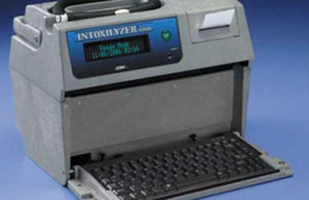Accused May Contest Test Results and Operability of Intoxilyzer 8000

The Intoxilyzer 8000 was the machine used to test a man’s breath-alcohol content following a 2011 accident in Cincinnati.

The Intoxilyzer 8000 was the machine used to test a man’s breath-alcohol content following a 2011 accident in Cincinnati.
A person charged with operating a vehicle while under the influence of alcohol has the right to challenge the accuracy of the specific results from the breath analyzer machine used to conduct a breath-alcohol test, the Ohio Supreme Court ruled today.
The court’s decision affirms the appellate court’s judgment, which upheld the trial court’s exclusion of evidence from the breath analyzer used to test Daniel Ilg because the Ohio Department of Health did not comply with a discovery order to provide Ilg with data from the machine.
The court’s unanimous decision, authored by Justice Terrence O’Donnell, noted that the director of the Ohio Department of Health is responsible for selecting machines that reliably determine an individual’s breath-alcohol concentration and that an accused is prohibited by statute from attacking the general scientific reliability of approved breath tests. However, Justice O’Donnell clarified that an accused is not prevented from challenging specific test results or whether the specific machine used in the test operated correctly.
In October 2011, Ilg lost control of his vehicle while driving in Cincinnati and hit a fence, sign, and pole. After police arrested him, Ilg submitted to a breath-alcohol test, which was conducted using an Intoxilyzer 8000 machine. The results showed a breath-alcohol concentration of 0.143, above the legal limit of 0.08.
Ilg was charged with operating a vehicle under the influence of alcohol and with a prohibited amount of alcohol in his breath, as well as with failing to maintain control of his vehicle.
He pled not guilty. He asked the court to suppress the results of his breath test and sought discovery of various records, including computerized online breath archives (COBRA) data, related to the Intoxilyzer 8000 machine used to test him.
The city did not produce the data, so Ilg subpoenaed a health department official for the records. At a hearing, the trial court ordered the health department to disclose the records. The official testified that the department did not have the personnel, technology, or resources to provide the COBRA data.
The trial court found that Ilg could not challenge the reliability of his breath test without the data from the Intoxilyzer 8000 and excluded the breath-test results from being used as evidence in the case.
The city appealed, and the First District Court of Appeals agreed with the trial court’s decision.
In today’s opinion, Justice O’Donnell noted that the General Assembly has given the director of Ohio’s health department the authority to adopt tests and procedures to analyze the alcohol and drug concentrations in certain bodily substances, and the director has approved the Intoxilyzer 8000 as a tool to accurately measure alcohol concentrations in the breath.
He explained that the Ohio Supreme Court’s decision in State v. Vega (1984) precluded an accused from making a general attack on the reliability of the breath-testing instruments approved by the director of health.
Justice O’Donnell pointed out that in this case, however, Ilg wanted COBRA data from the specific Intoxilyzer machine that tested his breath to challenge whether it operated properly on the day he was arrested, not to question the reliability of the Intoxilyzer 8000 machines in general.
“Ilg sought discovery of relevant, admissible evidence, and the trial court ordered the city to produce it, but because neither the city nor [the health department] complied with the order to produce, the trial court excluded the results of his breath test, and the court of appeals upheld that decision,” Justice O’Donnell wrote. “Here, the sanction is warranted ….”
“[T]he approval of a breath-analyzer machine by the director of the Ohio Department of Health as a device to test breath-alcohol concentration does not preclude an accused from challenging the accuracy, competence, admissibility, relevance, authenticity, or credibility of specific test results or whether the specific machine used to test the accused operated properly at the time of the test,” he concluded.
Joining the majority opinion were Chief Justice Maureen O’Connor and Justices Paul E. Pfeifer, Judith Ann Lanzinger, Sharon L. Kennedy, and Judith L. French. Justice William M. O’Neill concurred only in the judgment of the court.
2013-1102. Cincinnati v. Ilg, Slip Opinion No. 2014-Ohio-4258.
 View oral argument video of this case.
View oral argument video of this case.
Please note: Opinion summaries are prepared by the Office of Public Information for the general public and news media. Opinion summaries are not prepared for every opinion, but only for noteworthy cases. Opinion summaries are not to be considered as official headnotes or syllabi of court opinions. The full text of this and other court opinions are available online.
Acrobat Reader is a trademark of Adobe Systems Incorporated.


